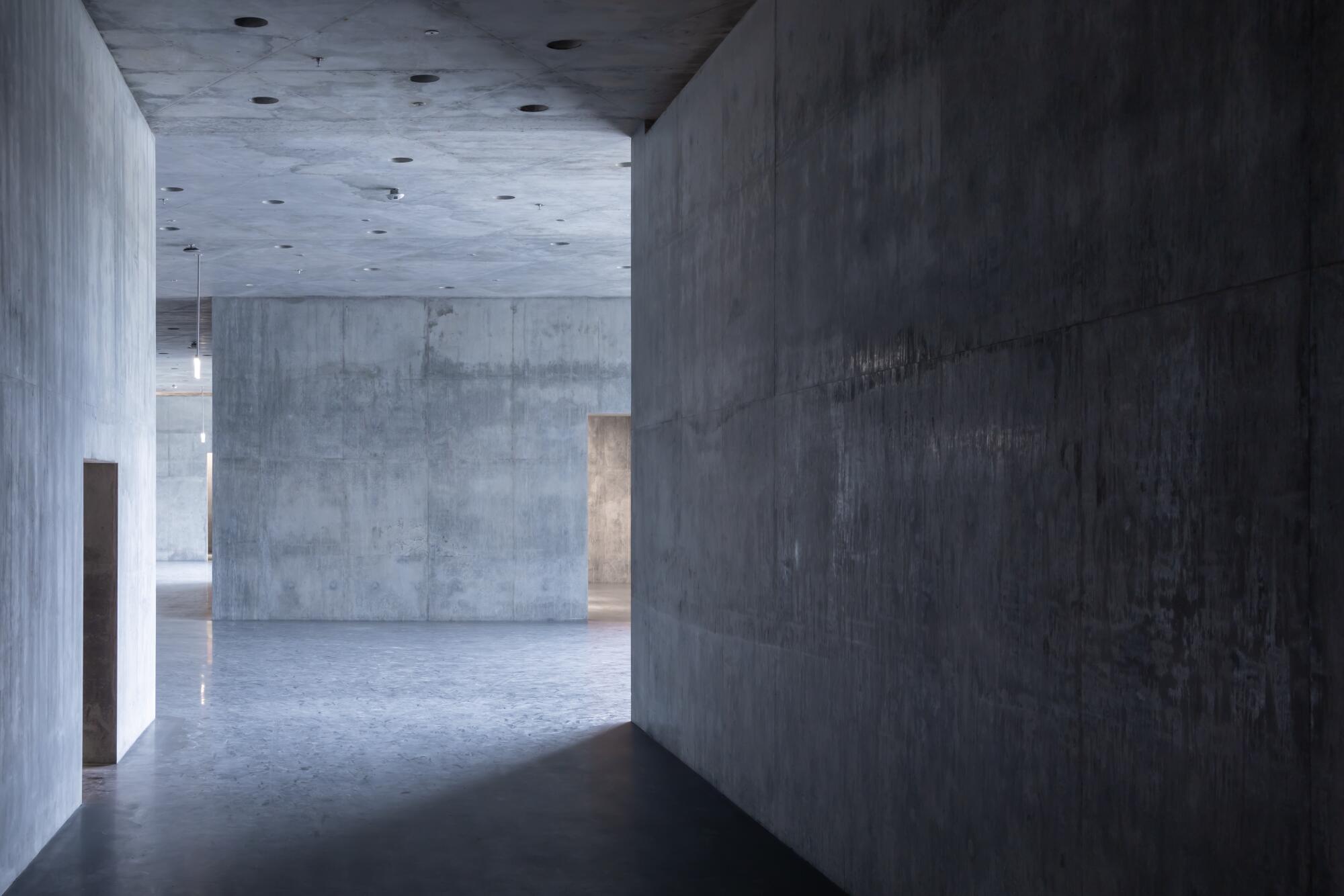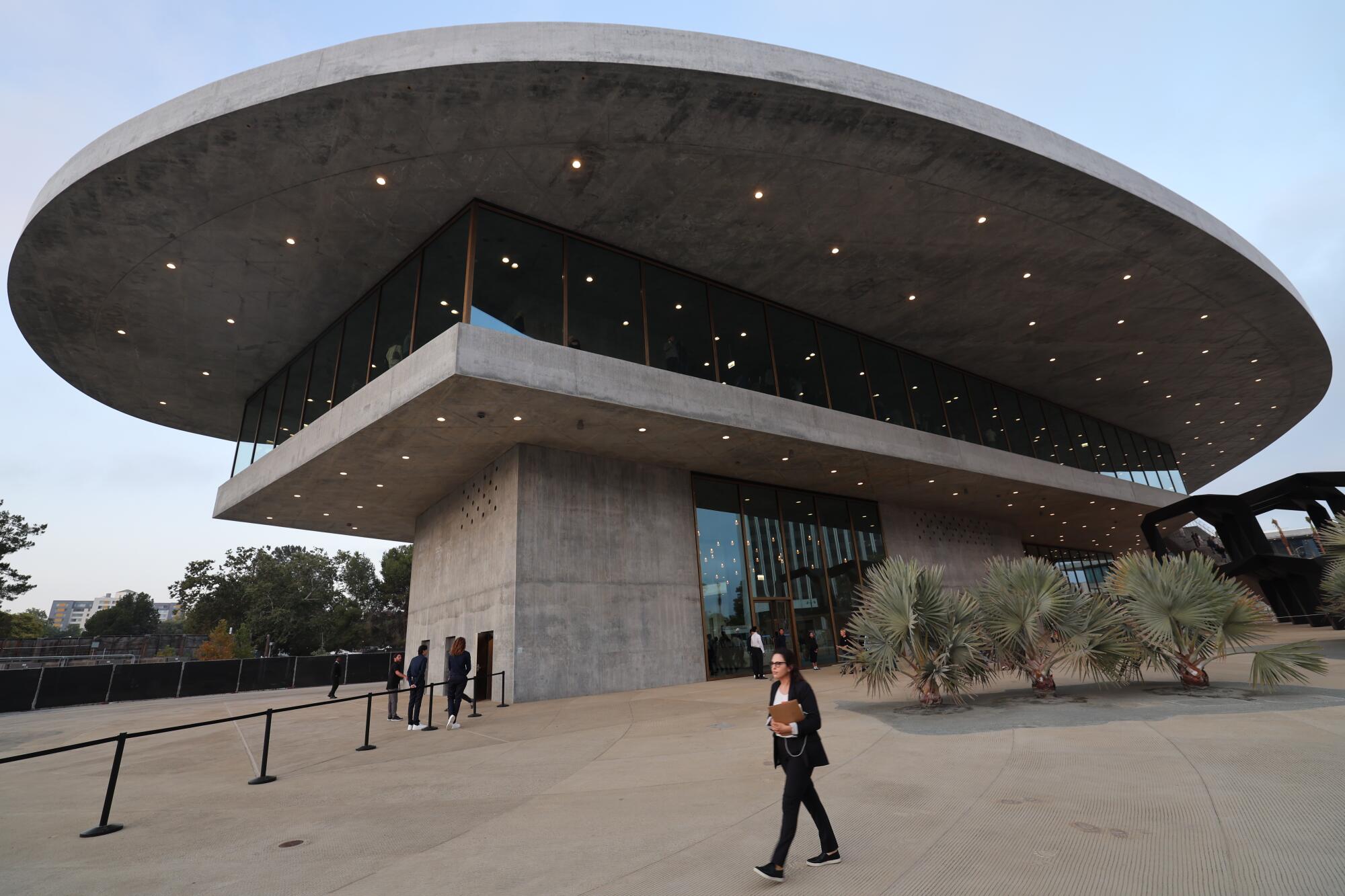
- Share via
A sneak peek of the building’s corridors and 90 bunker-like galleries reprises concerns about the plan to hang ever-rotating art by drilling holes in all that concrete.
The preview event Thursday comes amid senior staff departures, including the COO, CFO and deputy director for curatorial and exhibitions.
Ever since Brutalist architecture emerged in the 1950s, the style has been polarizing. Concrete might be gray, but public response rarely enters into gray areas. The buildings’ raw, unfinished concrete forms, typically simple, are loved or hated.
The Los Angeles County Museum of Art is nearing completion of its own new Brutalist building, designed by Swiss architect Peter Zumthor, 82, to house the permanent collection of paintings, sculptures and other works of art. For three days and one evening, beginning July 3, museum members will get a sneak peek at the empty interior spaces of the David Geffen Galleries. The fully finished project, with art installed, doesn’t open until April 2026.
Concrete is not eco-friendly, either in production or in results like heat magnification, and some celebrated architects with a social justice bent refuse to use it. But its visual power is undeniable — a strength of the huge Zumthor design. His poured-in-place concrete gobbles 347,500 square feet, including 110,000 square feet in 90 exhibition galleries and corridors lofted 30 feet above ground atop seven massive piers, crossing Wilshire Boulevard.
Los Angeles County Museum of Art’s long-awaited David Geffen Galleries building opens for a sneak peak Thursday -- the first look inside the raw, empty interior of architect Peter Zumthor’s poured concrete creation.
Some of my favorite art museum buildings are Brutalist in design, like Marcel Breuer’s fortress-like former Whitney in New York (1966), and Louis Kahn’s refined classicism at the Kimbell in Fort Worth (1972). Brad Cloepfil’s Clyfford Still Museum in Denver, which may be the best new American museum built for art in the last 15 years, uses concrete brilliantly to illuminate Still’s rugged painting motifs. Zumthor’s Geffen doesn’t come close.
I’ve written a lot about the long-aborning LACMA project over the last dozen years, focused on the design’s negative impact on the museum program, but that’s now baked in. (The museum pegs the building cost at $720 million, but sources have told me the entire project cost is closer to $835 million.) L.A.’s encyclopedic museum, with a global permanent collection simply installed geographically as straightforward chronology, is dead, and the Geffen Galleries prevent it from ever coming back. Changing theme shows drawn from the collection, curatorially driven, are the new agenda.

Having theme galleries is like banishing the alphabet that organizes the encyclopedia on your shelf. Chronology and geography are not some imperialistic scheme dominating global art. They just make finding things in a sprawling encyclopedic art collection easy for visitors. Good luck with that now.
I’ve pretty much avoided consideration of the building’s aesthetics. The exception was a 2013 column responding to “The Presence of the Past,” a somewhat clumsy exhibition of Zumthor’s still-evolving design conception, which has changed greatly in the final form. Reviewing purpose-built architecture is a fool’s errand when you can’t experience the purpose — impossible for another 10 months, when the art-installed Geffen opens.
A press event Thursday allowed entry into the gallery spaces, however, so a few things are now obvious. One is that museum galleries are theatrical spaces — there’s a reason they’re called shows — and chances are you’ve never seen so much concrete in one place. Sometimes it’s sleek and appealing, sometimes splotchy and cracked. (Surface mottling could soften over time.) But across floors, walls and ceilings of 90 bunker-like rooms and long, meandering corridors, the limitless concrete is monotonous. Grieg’s “In the Hall of the Mountain King” meets Beckett’s theater of the absurd.
Another is that views from the floor-to-ceiling windows that surround the building will offer lovely, interesting city vistas — welcome relief from the monotony. (Curtains will be installed around the perimeter.) A third is that the light, some entering horizontally from the side windows and a couple thin clerestory slots, but much of it from fixed vertical ceiling cans, is going to be a problem.
Those windows are also one of the biggest design losses in the value-engineering, undertaken to control ballooning costs. (Adjusted for inflation, the original Whitney Museum’s construction cost per square foot was about $633, Kimbell’s was about $469, and LACMA clocks in at $1,400, according to its website. Brutalist, indeed.) The floor plate was originally planned to follow the organic curves of the ceiling plate, with continuous, hugely expensive curved-glass windows linking the two. Now the floor plan is largely rectilinear.
The glass panels had to be flat, so the composition is a bit more dynamic. But the roofline overlaps can be jarring. At one end the hovering curved roof looks like a pizza too big for the box below.

Also daunting: Art will be hung on all that concrete by drilling holes in the walls and pounding in anchors. Moving the art will be cumbersome, requiring concrete patching. The entire process is labor-intensive and expensive.
Zumthor is the sixth architect to have had a whack at LACMA, following earlier efforts by William L. Pereira, Hardy Holzman Pfeiffer Associates, Bruce Goff, Rem Koolhaas, and Renzo Piano. Koolhaas never got beyond the proposal stage, although his marvelous idea pioneered the teardown-then-build-a-pavilion-on-stilts plan now coming to very different fruition. Only Goff produced a notable building, with a novel Japanese Pavilion that conceptually turned inside out the spiral Guggenheim Museum by his mentor, Frank Lloyd Wright. (Happily, the Japanese Pavilion can now be seen from the street.) The rest were mostly meh, salted with an occasional ugh.
Zumthor and LACMA Director Michael Govan pronounce the new Geffen building to be “a concrete sculpture,” which is why it’s being shown empty now. The cringey claim is grandiose, and it makes one wonder why being architecture is not enough. If it’s true, it’s the only monumental sculpture I know that has a couple of restaurants, an auditorium and a store. Apparently, an artistic hierarchy exists, with sculpture ranked above architecture.
That’s odd, because we’ve also been repeatedly told that LACMA built the place to undermine such conceits. Museum officials are still banging away on the absurd claim that a single-story building for art, banishing distinctions between “upstairs/downstairs,” confers an egalitarian marker on what global cultures produce. Hierarchy, however, is not a matter of physicality or direction, but of conceptual status. Rosa Parks was riding on a single-level bus, not a double-decker, and she knew exactly what her mighty refusal to sit in the back meant.

LACMA should be half as savvy. Climb the 60-plus steps up to the Geffen Galleries, or take an elevator, and when you arrive some art will be out front and some out back. Surely, we won’t regard that front/back difference as anti-egalitarian.
Will the Geffen Galleries be successful? My crystal ball is broken, but I see no reason why it won’t be a popular attraction. And that is clearly the museum’s priority.
An urban environment with a talented architect’s unusual art museum design tagged by a monumental topiary sculpture on the main drag — that’s a description of Frank Gehry’s incomparable Guggenheim Bilbao, the great 1997 museum in Basque northern Spain, where Jeff Koons’ marvelous floral “Puppy” sculpture holds court out front. (Every palace needs topiary, a leafy green power emblem of culture’s control over nature; Koons’ 40-foot-tall West Highland white dog makes for an especially cuddly symbol of guardianship.) Now the description fits LACMA too.
The museum just announced the acquisition of Koons’ floral behemoth, “Split-Rocker,” a rather bland hobby horse topiary that merges a toy dinosaur’s head with the hobby horse’s head. LACMA is next door to the La Brea Tar Pits & Museum, and the kiddie dino, a natural history plaything, forces a shotgun wedding with a degraded example of art history’s triumphant motif of a man on a horse. Govan worked on Bilbao before coming to L.A., and the formula there is being repeated here. L.A.’s eye-grabbing building won’t be as great nor its Instagram-ready topiary be nearly as good as the Bilbao ensemble, but when does lightning strike twice?
As museums, Bilbao and LACMA couldn’t be more different. One has a small, mostly mediocre permanent collection of contemporary art, while the other has a large, often excellent permanent collection of global art from all eras. The so-called Bilbao Effect sent cultural tourism, then already on the rise, skyrocketing. With the David Geffen Galleries, LACMA has put its very expensive eggs in that tourism basket.

It might take some time to work. The U.S. is the world’s largest travel and tourism sector, but it’s the only one forecast by the World Travel & Tourism Council to see international visitor decline in 2025 — and probably beyond. Between erratic pandemic recovery and an abusive federal government hostile to foreigners, worries are growing in L.A. about the imminent soccer World Cup and the Olympics.
It’s also surprising that the museum is now bleeding critical senior staff, just as LACMA’s lengthy transformation from a civic art museum into a tourist destination trembles on the verge of completion. Previously unreported, chief operating officer Diana Vesga is already gone, deputy director for curatorial and exhibitions J. Fiona Ragheb recently left, and chief financial officer Mark Mitchell departs next week.
Those are three top-tier institutional positions. Let’s hope they don’t know something we also don’t know.
More to Read
The biggest entertainment stories
Get our big stories about Hollywood, film, television, music, arts, culture and more right in your inbox as soon as they publish.
You may occasionally receive promotional content from the Los Angeles Times.












